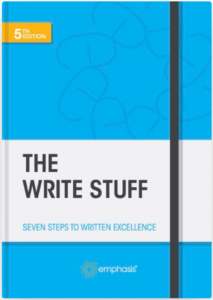
It’s easy to treat subheadings as a token afterthought once you’ve gone through the hard work of actually writing your document.
But it’s worth paying more attention to them than that. They can be an effective tool in drawing your reader in to your full text or helping them find your most important points.
Want to find out how?
Watch the video
Video transcript
Can’t watch the video now? Here’s the transcript:
Guide the way with subheading signposts
You know how it is.
You’ve written your document. Now you want people to read it (or what was the point?).
You probably know no one wants to look at a big block of text, so you break it up.
Good start. But that’s not enough, is it?
No, you also need ‘signposts’ – like subheadings.
Well, that looks better already.
And subheadings don’t just help your writing look good and your documents more inviting. They can work much harder than that. More on that in a minute.
But first, a word of warning.
Far too often, people write subheadings like these:
Background
Our experience
Recommendations
Background: What does that tell you about what’s coming? Not much.
Our experience: Is that specific? Not really.
Recommendations: Are you engaged by this?
Do you want to follow these signposts? Probably not.
If you’re trying to find your way in the world, a signpost will be no help at all if it doesn’t actually tell you what it’s pointing to.
And, just like signposts you’d follow to get somewhere, your subheadings have to be specific. They have to tell your reader exactly what’s ahead, to help them get where they need to go.
Even better if your subheading signposts make the reader want to go there.
For example:
Background ➜ What you told us
Our experience ➜ 40 years in the business
Recommendations ➜ How we’ll meet your aims
So, what techniques can you use to inspire subheadings that not only draw your reader in but also lead them through your document?
Well, remember: well-written subheadings can make your reader want to … dive in. So try some of these techniques.
Direct
Interest
Verbs
Evoke curiosity with a question
Insight (to expand on)
Numbers
Play on words (if appropriate)
Short (ish)
Make sure your subheadings are direct and to the point.
‘Corporation tax rate reduced’
Say something that will be of interest to the reader.
‘How to expand our customer base’
Try using verbs – remember, those are the ‘doing’ and ‘being’ words. Doing so sounds dynamic and might even encourage action in some cases.
‘Industry achieves positive change’
Evoke curiosity with a question.
‘Ready for the low-carbon future?’
Give an insight that you’ll expand on in the following section.
‘Real estate to outperform’
Try including a number – a technique often used online, which lets your reader know exactly how much information to expect.
‘Five ways to combat climate change’
And there’s a PS …
You can use a play on words – but only if you think it’s appropriate to the tone of your document and the intended reader.
‘Face the storm with catastrophe bonds’
And finally: remember to keep your subheadings short … ish. They should be long enough to be meaningful but short enough to be understood and absorbed quickly.
So, try some of these techniques for signposting your next document and see how far it takes you.
Subheadings in summary
Remember, the best subheadings will read like an overview of your document – but they should also be compelling enough to encourage readers to dive in to the main copy. If you write online content, like blog posts, remember that website visitors do tend to skim-read a page before deciding whether to stay on it. The right subheadings could help tip the balance in your favour.
Help your readers navigate
In an ideal world, your documents and emails would never be skim-read. But, realistically, some of your time-pressed colleagues or clients will have to do just that. In which case, well-chosen subheadings will at least give them a summary and help them quickly find the most relevant parts.
Find your route
Subheadings can also help you with your writing process: try coming up with them as part of the planning stage before you write the body of the document, when you’re deciding the structure. Or, if you prefer, you could read through the ‘summary’ your subheads make after you’ve finished the document to double-check its structure: did you pick the best ‘route’? You can then adjust the order if necessary (but don’t forget to make sure the text still flows logically).
Keep it appropriate
Just like anything else you write, judge the suitability of your subheadings against the tone of the document and what you know about the reader.
This post is taken from a lesson in our e-learning programme The complete business writer, which improves your writing (or your team’s) in practical, bite-sized lessons. You can find out more about the e-learning and demo two lessons here.
Image credit: Brenda Carson / Shutterstock







